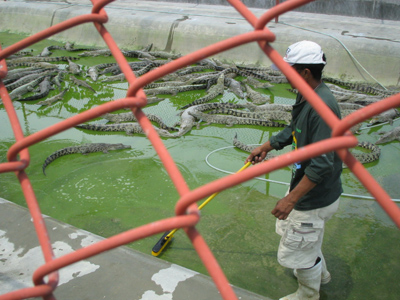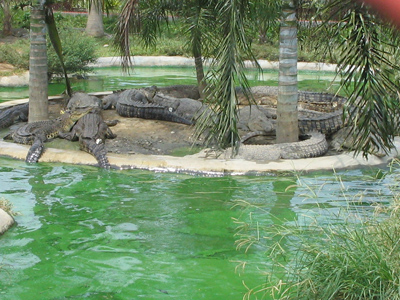Crocodile Farm in Davao
DAVAO CROCODILE PARK
Steve Irwin may be gone, but he would be happy knowing that in this part of the world, some people were completely bitten by crocodiles. Well, not literally, of course. With the Davao Crocodile Park going strong after ten years, Mr. Irwin is assured that in this city, the crocodiles are treated with respect that they deserve.
The Davao Crocodile Park have just transferred to its new address in Riverfront Corporate City – their new home since August 2006 and a wonderfully lot better than the old one – well-planned lay-out and conspicuously clean.
If you are visiting Davao City for the first time, the Davao Crocodile Park is a mere 15 minute ride from Davao City’s downtown area. If you want to commune with nature during your trip to Davao, why not include the crocodiles in your itinerary?
Take the Maa route or you may pass through the Diversion Road. Either way, the park is not hard to find. It is at the far end of the still-vacant upscale subdivision being developed by the Sta. Lucia Properties. And if you have time to spare, you can drop by at the Butterfly House, which incidentally is a few meter away from the park and shows off 18 local species of butterflies in their various development stages.
But for those who wants excitement, danger, or be astounded by size and ferocity beyond belief – go straight ahead and look for this façade.
Getting inside sets you back PhP 75.00 if you’re an adult, and PhP 50.00 for every child. If you think that’s too expensive for a ticket price, you better come in the afternoons past 3.00 PM between Friday to Sunday when they hold Animal Shows and you get your money’s worth oohhing---aahhing over the animals’ ferocious skills and other amazing antics, the tightrope walker (aren’t you glad you have a different job?), and the chance to pet the animals.
The park’s main attractions are the crocodiles, naturally. In fact, they have different park facilities solely for the propagation of these intimidating reptiles. There’s an Incubation room which is totally restricted to the public. There’s a Nursery Room too, filled with lizard-like creatures. When they get big enough, they are transferred to two yearling pens that must have contained about 50-60 smaller crocodiles between the ages one to three years old.
Now, that’s one place you wouldn’t want to be, especially if they have not been fed yet. Those yearlings are quite agile – just a few nudges here and there, splash of water from a water hose – and you’ll get yourself a small mutiny. And yes, it’s a horrible life inside that pen, because according to the caretaker, they keep finding pieces of tail or head once in a while. He also added, that during feeding time, the crocs tend to get too impatient and snap at them instead, literally. The man sustained quite a few bite marks himself and without prodding, he hitched his pants higher show off his tell-tale scars.

Then there are three breeding ponds over to the left side, literally teeming with languid creatures. They stretch out, soaking up the sun and completely unflappable with all the excited noise from the spectators as well as the flashing of camera bulbs. When a croc enters the water, there’s quite a green slush everywhere.

But the most breathtaking of all these crocs is Pangil (which is a Filipino translation of the world fang). Reportedly the country’s second largest at 18 feet long, this giant (by local standards) must be more than 60 years old. He has the pond all by himself and he can hold everybody’s attention by just sitting there, exposing his immensity to the curious. (see Pangil’s pix)
Don’t worry about the crocodiles jumping out of their pens to have you for a meal. They are amply fed, with two piggeries supplying them with raw meat. Pangil gets his 5 kilos of meat twice a weak, the yearlings get their 20 kilos thrice a week and the breeders get their 60 kilos thrice a week too.
School season brings a lot of excursion to the park. March and August also draw in tourists inside the park. At peak dates, visitors could be as many as 10,000 a week.
(see photo above)
Having your fill of crocs, you might want to check other animals in small cages or glass-encased enclosures. There are raucous parrots, eagles and mynahs (a black keeps calling everyone who pass by “Pangit!” (ugly). Snakes are coiled inside their cages, their heads tucked under their shiny skins. A lone ostrich keeps on prancing about, flapping its small wings and showing off its big butt. There’s a bearcat hanging precariously on a branch and in front is a swinging orangutan. Smaller animals such as macaques, porcupine, civet, leopard cat, monitor, and deer have their own cages too.
It is almost like having your own tiny jungle in the middle of a bustling metropolis.
And the city would just have to thank Mr. Philip Dizon for setting-up the park. Without his long-time fascination with crocodiles, a lot of Davaoeños would be ill-informed about the role these reptiles play in the food chain; and tourists would have one less interesting place to remember Davao City with.

But the park is not all educational, tourism and entertainment.
In reality, the park makes good business selling the crocs. These fellas here might be cold-blooded predators in the wilds, but when farmed commercially, their meat can fetch as much as US$900 while the hide, when tanned and made into leather, can command higher price, later to be used in bags, shoes and belt.
In fact, the park supplies crocs to another crocodile farm in Palawan (in northern part of the country).
For this purpose, the park also maintains an off-site breeding center to complement its production.
When you’re thirsty after circling the park (it’s just about a hectare in size) and ogling these animals, you can try the park’s dragon fruit shake (P55 per glass) or any other tropical fruits in season (see pix). There’s also an adjacent restaurant that serves grilled food.
When you reach the end of your tour, there’s a souvenir shop that sells croc teeth pendants and other mementos that will remind you of your visit to the park, and to Davao City.
And if you can’t come just yet to Davao City, you can visit their website at www.davaocrocodilepark.com.


0 Comments:
Post a Comment
<< Home